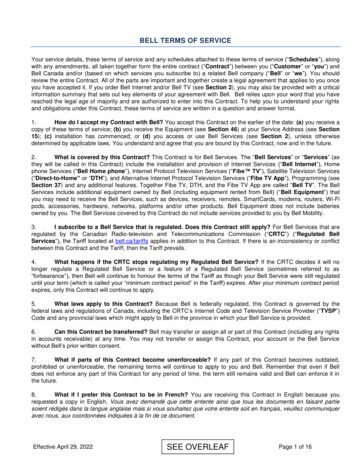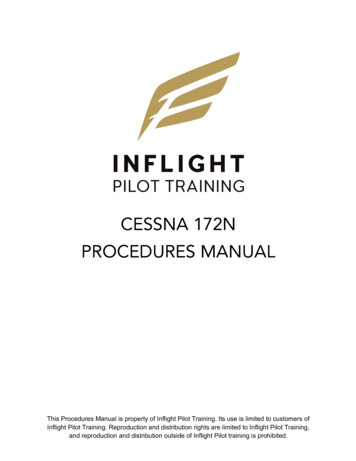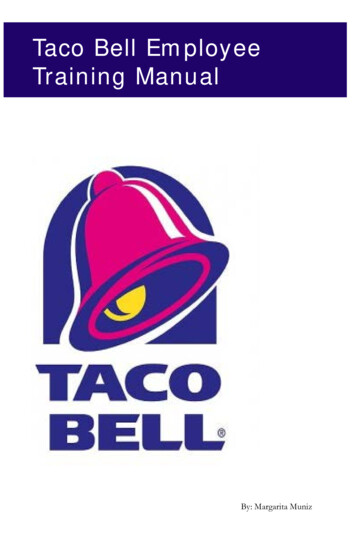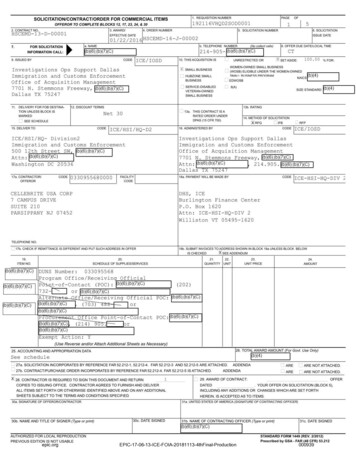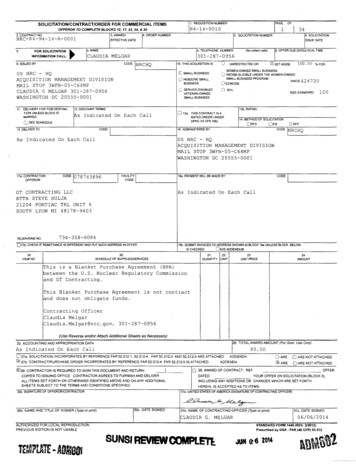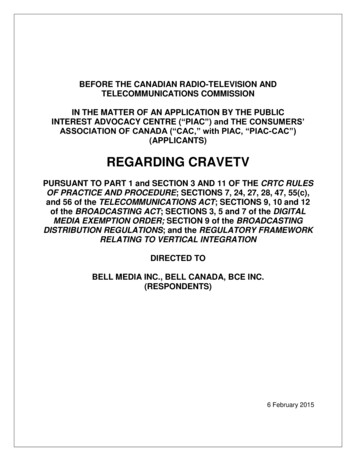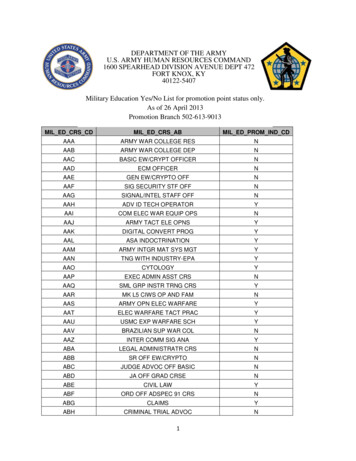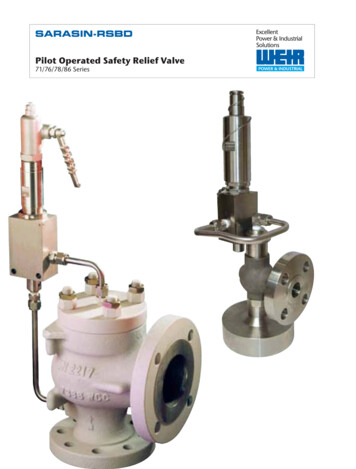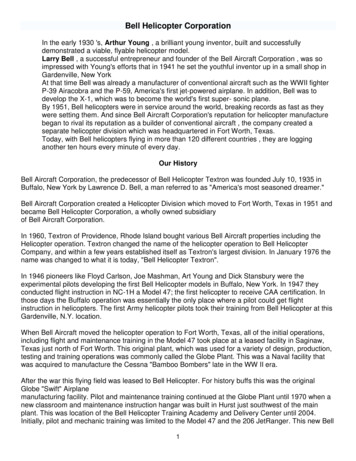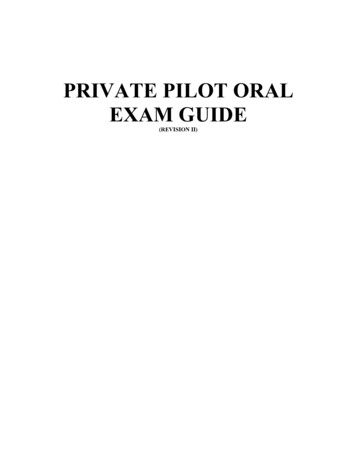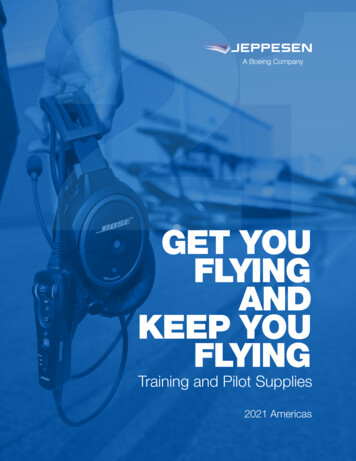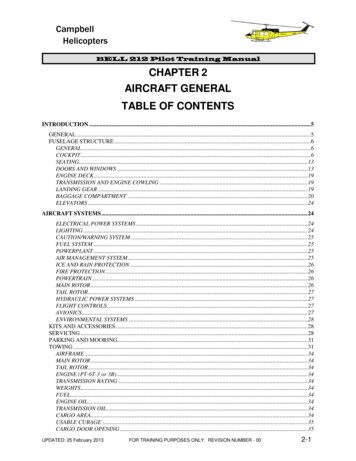
Transcription
CampbellHelicoptersBELL 212 Pilot Training ManualCHAPTER 2AIRCRAFT GENERALTABLE OF CONTENTSINTRODUCTION .5GENERAL .5FUSELAGE STRUCTURE .6GENERAL .6COCKPIT .6SEATING.13DOORS AND WINDOWS .13ENGINE DECK.19TRANSMISSION AND ENGINE COWLING .19LANDING GEAR .19BAGGAGE COMPARTMENT .20ELEVATORS .24AIRCRAFT SYSTEMS.24ELECTRICAL POWER SYSTEMS .24LIGHTING .24CAUTION/WARNING SYSTEM .25FUEL SYSTEM .25POWERPLANT .25AIR MANAGEMENT SYSTEM.25ICE AND RAIN PROTECTION .26FIRE PROTECTION .26POWERTRAIN .26MAIN ROTOR .26TAIL ROTOR.27HYDRAULIC POWER SYSTEMS .27FLIGHT CONTROLS .27AVIONICS .27ENVIRONMENTAL SYSTEMS .28KITS AND ACCESSORIES .28SERVICING .28PARKING AND MOORING.31TOWING .31AIRFRAME .34MAIN ROTOR .34TAIL ROTOR.34ENGINE (PT-6T-3 or 3B) .34TRANSMISSION RATING .34WEIGHTS.34FUEL.34ENGINE OIL .34TRANSMISSION OIL .34CARGO AREA.34USABLE CUBAGE .35CARGO DOOR OPENING .35UPDATED: 25 February 2013FOR TRAINING PURPOSES ONLY. REVISION NUMBER - 002-1
CampbellHelicoptersBELL 212 Pilot Training ManualLIMITATIONS.35GENERAL .35WEIGHT/CENTER OF GRAVITY .35Weight .35Center of Gravity .35LOADING .35Passenger Loading .35Internal Cargo Loading .35OPERATING .36Type of Operation .36Required Equipment - IFR .36Flight Crew .36Doors Open and Removed .36Altitude .36Ambient Air Temperature .36Height-Velocity .37Maneuvering .37AIRSPEED .37INSTRUMENT MARKINGS .37AIRSPEED INDICATOR MARKINGS .37Dual Torque Indicator (Twin-Engine Operation) .37Dual Torque Indicator (Single-Engine Operation) .37Triple Tachometer .38Rotor RPM (N R ) .38Engine RPM (N2) .38Gas Producer RPM (N 1 ) .38Transmission Oil Temperature.38Transmission Oil Pressure .38Engine Oil Temperature.38Engine Oil Pressure .38Combining Gearbox Oil Temperature .39Combining Gearbox Oil Pressure .39Ammeter .39Interturbine Temperature (ITT) .39Hydraulic Oil Temperature .39Hydraulic Oil Pressure .39UPDATED: 25 February 2013FOR TRAINING PURPOSES ONLY. REVISION NUMBER - 002-2
CampbellHelicoptersBELL 212 Pilot Training ManualILLUSTRATIONSFIGURE 2-1 BELL 212 MAJOR SECTIONS .8FIGURE 2-2 BELL 212 EXTERIOR DIMENSIONS .9FIGURE 2-3 BELL 212 FUSELAGE PRIMARY STRUCTURE .10FIGURE 2-4 COCKPIT LAYOUT (TYPICAL) .11FIGURE 2-5 SEATING ARRANGEMENTS .12FIGURE 2-6 SLING SEAT .13FIGURE 2-7A COCKPIT DOOR.14FIGURE 2-7B BUBBLE WINDOW.14FIGURE 2-9A CARGO/PASSENGER DOORS .14FIGURE 2-9B CARGO/PASSENGER DOORS .14FIGURE 2-9C CARGO/PASSENGER DOORS .15FIGURE 2-9D CARGO/PASSENGER DOORS .15FIGURE 2-10A HINGED DOOR PANEL .16FIGURE 2-10B HINGED DOOR PANEL WITH PROTECTIVE FAIRING .16FIGURE 2-11 DOORS AND PANELS (SHEET 1 OF 2) .17FIGURE 2-12 DOORS AND PANELS (SHEET 2 OF 2).18FIGURE 2-13 WINDSHIELDS .19FIGURE 2-14 ENGINE DECK .19FIGURE 2-15 TRANSMISSIONS AND ENGINE COWLING .20FIGURE 2-16 SKID LANDING GEAR .21FIGURE 2-17A EMERGENCY FLOATS (TOP) AND PASSENGER STEP KIT .21FIGURE 2-17B PASSENGER STEP KIT VARIANTS IN USE WITH FLOATS.22FIGURE 2-18 BAGGAGE COMPARTMENT.23FIGURE 2-19 SYNCHRONIZED ELEVATORS .24FIGURE 2-20 INSPECTION AND SERVICING (SHEET 1 OF 2).29FIGURE 2-20 INSPECTION AND SERVICING (SHEET 2 OF 2).30FIGURE 2-21 PARKING AND MOORING.31FIGURE 2-22 TOWING .32FIGURE 2-22 TOWING-2.33UPDATED: 25 February 2013FOR TRAINING PURPOSES ONLY. REVISION NUMBER - 002-3
CampbellHelicoptersBELL 212 Pilot Training ManualThis page intentionally left blank.UPDATED: 25 February 2013FOR TRAINING PURPOSES ONLY. REVISION NUMBER - 002-4
CampbellHelicoptersBELL 212 Pilot Training ManualCHAPTER 2AIRCRAFT IN GENERALINTRODUCTIONThis training manual provides a description of the major airframe and engine systems installedin the Bell 212 Twin. This information is intended as an instructional aid only; it does notsupersede, nor is it meant to substitute for any of the manufacturer's system or operatingmanuals. Material presented has been prepared from the basic design data. All subsequentchanges in aircraft appearance or system operation will be discussed during academic trainingand subsequent revisions to this manual.GENERALThe Bell 212 is a twin turbine, two bladedsingle main rotor, medium lift helicopterdesigned to carry up to 15 persons,including the pilot(s). Thirteen passengerseats can be installed in the aft cabin, andthe left pilot seat may be used for apassenger when one pilot flies the aircraft.A Bell IFR helicopter must be operated withtwo pilots when operated IFR. It can beoperated single-pilot when VFR.The Model 212 is designed for highperformance,lowmaintenanceandmaximum versatility. Operational reliability isimproved with the twin turbo-shaft engineinstallation.Special equipment allows for over waterflight, transportation of external cargo, andUPDATED: 25 February 2013hoist operations. The helicopter is poweredby the Pratt and Whitney PT6T-3 or thePT6T-3B or the PT6T-3DF “TwinPac”power plant, 1,800, 2050, or 2260 shafthorsepower powerplant respectively drivinga semirigid underslung two bladed rotorsystem. Campbell machines are typicallypowered by PT6T-3’s but there isoccasionally one or more PT6T-3B poweredmachines in the fleet.The main rotor is a two bladed, semi rigid,seesaw, high kinetic energy type, withpreconing and under-slinging capabilities toincrease stability and provide smoothcontrol response in all modes of flight.The main transmission is a single stagebevel gear unit; a two-stage planetary geartrain and a tail rotor drive system take-off.The original transmission incorporated afreewheeling unit at the input shaft. ThisFOR TRAINING PURPOSES ONLY. REVISION NUMBER - 002-5
CampbellHelicoptersBELL 212 Pilot Training Manualfreewheeling unit was removed from the latermodel transmissions.Most upgradedtransmissions (5000 hrs TBO) are nowmonitored by a triple zone chip detectorsystem although some legacy models withthe single chip detector remain in service.The Bell 212 fuel system features severaladvanced safety features, including selfsealing, breakaway fittings and ruptureresistant fuel cells.With a standard fuel load, the 212 isdesigned to cruise at approximately 100knots (3,000 feet and below) with a 200nautical mile range. Auxiliary tanks canextend range to 340 nautical miles. Thereare three approved auxiliary fuel tank kitspresently available. Two of the three kitsare internal kits, consisting of 40 gallon and180galloncapacitiesrespectively.Maximum gross weight is 11,200 pounds,with a payload of approximately 4,200pounds for the VFR only (approx 3,800 forthe IFR aircraft).The Bell 212 Twin is certificated for singlepilot operation. In basic configuration, it isapproved for operation under day or nightVFR, non-icing conditions.The IFRconfigured helicopter is certificated forCategory 1 IFR operation during day ornight non-icing conditions.The flightmanual gives limitation procedures andperformancedataforCategoryAoperations. Figure 2-1 shows the Bell 212aircraft major sections. Figure 2-2 showsthe exterior dimensions of the aircraft.FUSELAGE STRUCTUREGENERALConversion from passenger to cargoconfigu ration is accomplished by removal ofthe seats. Without seats, the cabin has 220feet of cargo space.The tail boom is an all metal semimonocoque structure with aluminum skin.The assembly in cludes the tail rotordriveshaft covers, vertical fin, elevators,baggage compartment, and tail skid. The tailboom attaches to the fuselage by four boltsand supports the tail rotor drive shafting, tailrotor gearboxes, tail rotor, synchronizedelevator and tailskid. The tail boom alsoincorporates a 28 cu. ft. baggagecompartment. The cabin accommodates amaximum of 15 personnel, including the pilotand co-pilot.A synchronized or sync elevator (horizontalstabilizer) is located near the aft end of thetail boom, to increase the controllability of thehelicopter and effectively lengthen the CGrange.Two retractable, quickly removable groundhandling wheels attach to fittings in the skidtubes (figure 2-21). A tubular steel tailskid isattached to the aft section of the tail boom towarn the pilot of a tail-low landing.COCKPITThe primary structure of the fuselage(Figure 2-3) consists of two main sections(aluminum alooy with fiberglass panels andhoneycomb structures), the forward fuselageand tail boom. The forward fuselage includesthe cabin, laminated glass (or more oftennoe plexiglass) windshields, acrylic plasticUPDATED: 25 February 2013windows, crew doors, cargo/passenger door,pylon and engine cowlings and landing gearis made of a combined semi-monocoque andreinforced shell construction with transversebulkheads and metal covering. It has twomain longitudinal beams that provide theprimary supporting structure. (Monocoquemeans a metal structure in which thecovering absorbs part of the stresses towhich the structure is subjected).The cockpit (Figure 2-4) can accommodatea crew of two, with the pilot normallyoccupying the right seat. Single pilotoperations are conducted from the rightseat. Long Line vertical referenceoperations are conducted from the left seat.FOR TRAINING PURPOSES ONLY. REVISION NUMBER - 002-6
CampbellHelicoptersBELL 212 Pilot Training ManualStandard cockpit features include heaterand ventilating systems.The standard 212 instrument panel isnormally equipped for VFR and IFR day ornight flight, although VFR only options areavailable and are the most commonCampbell variant. Engine and transmissioninstruments and the caution panel areUPDATED: 25 February 2013grouped in the center section of the panelfor easy observation from either seat. Flightand navigation instruments are grouped onthe right side of the panel in front of thepilot. Additional co-pilot instruments areinstalled in the left side of the instrumentpanel for two pilot operations. Theinstruments have complete white lighting.FOR TRAINING PURPOSES ONLY. REVISION NUMBER - 002-7
CampbellHelicoptersBELL 212 Pilot Training ManualFigure 2-1UPDATED: 25 February 2013Bell 212 Major SectionsFOR TRAINING PURPOSES ONLY. REVISION NUMBER - 002-8
CampbellHelicoptersBELL 212 Pilot Training ManualFigure 2-2UPDATED: 25 February 2013Bell 212 Exterior DimensionsFOR TRAINING PURPOSES ONLY. REVISION NUMBER - 002-9
CampbellHelicoptersBELL 212 Pilot Training ManualFigure 2-3UPDATED: 25 February 2013Bell 212 Fuselage Primary StructureFOR TRAINING PURPOSES ONLY. REVISION NUMBER - 002-10
CampbellHelicoptersBELL 212 Pilot Training ManualFigure 2-4UPDATED: 25 February 2013Cockpit Layout (Typical)FOR TRAINING PURPOSES ONLY. REVISION NUMBER - 002-11
CampbellHelicoptersBELL 212 Pilot Training ManualFigure 2-5Seating Arrangements(At Campbell normally only Cargo and Personnel arrangements)UPDATED: 25 February 2013FOR TRAINING PURPOSES ONLY. REVISION NUMBER - 002-12
CampbellHelicoptersBELL 212 Pilot Training ManualSEATINGDOORS AND WINDOWSThe pilot seats are a tubular constructioncovered with a nylon mesh for ventilation.Attached to each seat, there is a standardseat belt and shoulder harness restraintsystem. The shoulder harness utilizes aninertia reel to provide inertial locking of theharness with a manual lock located to theleft side of the seat itself. The seats arelocated on tracks for fore and aft adjustmentand are also adjustable in the vertical plane.The fore and aft lock for the seat is on theforward left side. The vertical adjustmentlock is located on the forward right side.Access to the cockpit is provided on eachside through large doors that are hinged onthe forward edge (Figure 2-7). A crew stepis built into the skid landing gear. Eachcrew door has three acrylic plastic windows,termed "forward," "upper," and "adjustable."The adjustable window slides up and downand has a screw device to lock it in anyposition. Most Campbell 212’s have abubble window on the left cockpit door tofacilitate long-lining (Figure 2-7). A latchassembly with L shaped handles and anintegral key lock secures the door in theclosed position. In an emergency, the crewdoors may be jettisoned by pulling theEMERGENCY EXIT handle located insideand forward of each door (Figure 2-8).The basic passenger seat structure isnormally the “jump seat” rip resistant nylontype, outfitted with a safety belt. Baggageor cargo stored under the passenger’sseats must be restrained by an approvedcargo or baggage tiedown.The passenger seat legs are not stressedfor cargo restraint.Figure 2-5 showsseveral typical seating options.The sliding cargo/passenger door on eachside (Figures 2-9a and 9b) has a latchingassembly with L shaped handles and anintegral key lock. The sliding doors can besecured in the open position when soequipped with the latching mechanism. Thetwo acrylic windows in each sliding door canbe jettisoned from either inside or outsideby applying approximately 50# of pressureto any of the four corners. On some oldermodel doors the windows are jettisoned bya rotatable latch protected by a pull offplastic cover located just below eachwindow.An 18-inch wide removable hinged doorpanel just forward of each sliding dooropens outward and forward to increase thetotal width of the opening for passengers orcargo. Figures 2-9 and 2-10 show the panelin the closed and open positions.The latch assembly on each door panel hasan L shaped handle located on the inside ofthe door. Most have a plastic fairing toprevent inadvertent of the latch (Figure 210b). Each hinged panel has an acrylicwindow that cannot be jettisoned.Figure 2-6UPDATED: 25 February 2013Sling SeatFOR TRAINING PURPOSES ONLY. REVISION NUMBER - 002-13
CampbellHelicoptersBELL 212 Pilot Training ManualFigure 2-7aCockpit DoorFigure 2-8Emergency Exit HandleFigure 2-9aCargo/Passenger DoorsUPDATED: 25 February 2013Figure 2-7bFigure 2-9bBubble WindowCargo/Passenger DoorsFOR TRAINING PURPOSES ONLY. REVISION NUMBER - 002-14
CampbellHelicoptersBELL 212 Pilot Training Manual5Figure 2-9cCargo/Passenger DoorsNote: (Inset 5) Make sure the latches areclosed before opening the sliding door. Thelatches maybe sheared off or jam thesliding door open. If the hinged doors areleft open their hinges may be sheared off.Note also the passenger step which istypical of that utilitzed on Campbell 212’s.Figure 2-9dUPDATED: 25 February 2013Cargo/Passenger DoorsFOR TRAINING PURPOSES ONLY. REVISION NUMBER - 002-15
CampbellHelicoptersBELL 212 Pilot Training ManualFigure 2-10aHinged Door PanelFigure 2-10bHinged Door Panelwith Protective FairingFigures 2-11 and 2-12 illustrate the namesand locations of the doors and panels formaintenance and servicing and the systemsand structures which they access.UPDATED: 25 February 2013FOR TRAINING PURPOSES ONLY. REVISION NUMBER - 002-16
CampbellHelicoptersBELL 212 Pilot Training ManualLEFT AND RIGHT SIDE VIEWS1External Power Receptacle8Engine Cowling2General Access Door9Tailpipe Fairing3Nose Compartment Access Door10 Lower Forward Cabin Window4Crew Door11 Electrical Compartment Access Door5Hinged Panel Door12 Heater Duct Access Door6Cargo Door13 Heater Compartment Access Door7Transmission FairingFigure 2-11UPDATED: 25 February 2013Doors and panels (Sheet 1 of 2)FOR TRAINING PURPOSES ONLY. REVISION NUMBER - 002-17
CampbellHelicoptersBELL 212 Pilot Training ManualFUSELAGE SKIN AND LEFT SIDE TAIL BOOM2General Access Door18Cargo Hook Opening14Nose Compartment Access19Baggage Compartment Door (RH Only)15Flight Control Access Door20Drive Shaft Cover16Fuel Line Access Door2142 Degree Gearbox Cover17Antenna22Tail Skid FairingFigure 2-12UPDATED: 25 February 2013Doors and Panels (Sheet 2 of 2)FOR TRAINING PURPOSES ONLY. REVISION NUMBER - 002-18
CampbellHelicoptersBELL 212 Pilot Training ManualThe two windshields (Figure 2-13) are madeof Plexiglas for VFR equipped aircraft (IFRaircraft have laminated glass windshieldsand are virtually free from distortion).Plexiglass windshields are very susceptibleto scratching and therefore use ofwindshield wipers should be avoided exceptin absolute necessity. Deet products arealso very
A Bell IFR helicopter must be operated with two pilots when operated IFR. It can be operated single-pilot when VFR. The Model 212 is designed for high performance, low maintenance and maximum versatility. Operational reliability is improved with the twin turboshaft engine - . BELL 212 Pilot Training Manual UPDATED: 25 February 2013 FOR .
